Email compliance with GDPR is crucial for organizations operating in the UK, as it mandates strict adherence to data protection and privacy regulations. By obtaining consent, providing clear information on data usage, and implementing security measures, businesses can foster trust and enhance engagement while minimizing the risk of penalties. Additionally, GDPR impacts lead generation strategies, requiring explicit permission from individuals before processing their personal data, thereby shaping how leads are collected and nurtured.
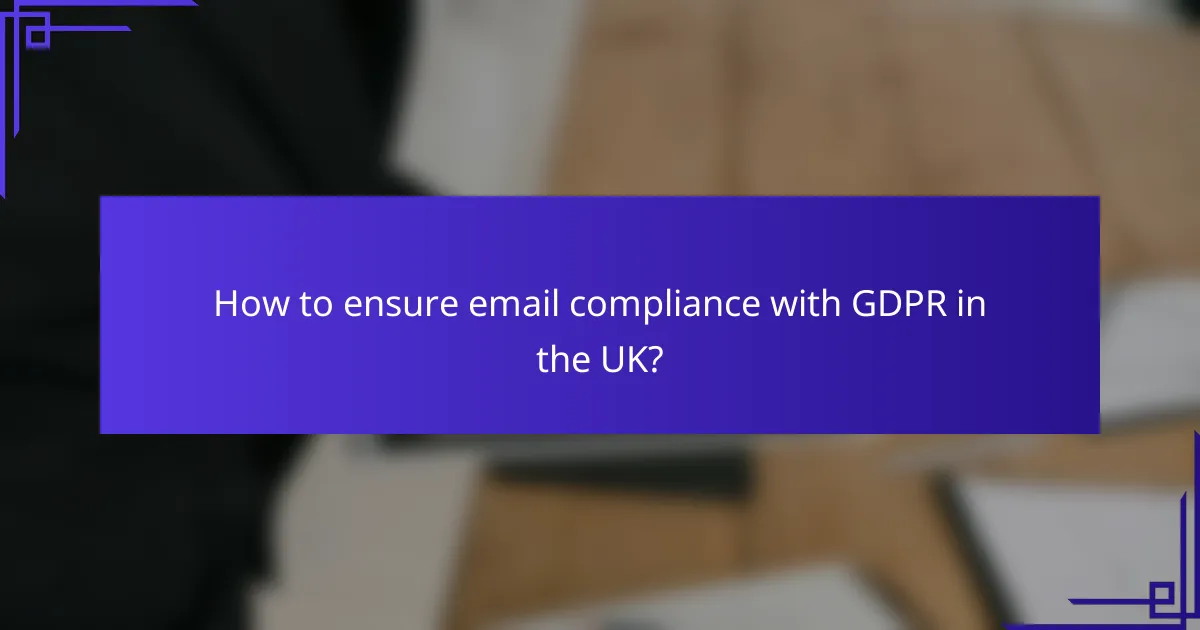
How to ensure email compliance with GDPR in the UK?
To ensure email compliance with GDPR in the UK, organizations must adhere to strict regulations regarding data protection and privacy. This includes obtaining consent from recipients, providing transparent information about data usage, and implementing robust security measures to safeguard personal data.
Obtain explicit consent
Obtaining explicit consent is a fundamental requirement under GDPR. This means that individuals must actively agree to receive marketing emails, rather than being opted in by default. Use clear language in your consent forms and ensure that users can easily withdraw their consent at any time.
For example, consider using checkboxes that are not pre-checked, allowing users to make an informed choice. Keep records of consent to demonstrate compliance in case of audits or inquiries.
Provide clear privacy notices
Clear privacy notices are essential for transparency. These notices should inform recipients about how their data will be used, stored, and shared. Include details such as the purpose of data collection, the legal basis for processing, and the rights of individuals regarding their data.
Make privacy notices easily accessible, such as linking to them in your emails or on your website. Use straightforward language to ensure that all recipients can understand their rights and your obligations.
Implement data protection measures
Implementing data protection measures is crucial for safeguarding personal information. This includes using encryption for email communications, regularly updating security software, and training staff on data protection practices. Regular audits can help identify vulnerabilities and ensure compliance with GDPR.
Consider adopting a data protection impact assessment (DPIA) for new projects involving personal data. This proactive approach helps to identify risks and implement strategies to mitigate them, ensuring ongoing compliance with GDPR requirements.

What are the best practices for email marketing compliance?
The best practices for email marketing compliance focus on respecting subscriber preferences and adhering to regulations like GDPR. Implementing these practices helps build trust, improve engagement, and reduce the risk of penalties.
Segment your email lists
Segmenting your email lists involves dividing your subscribers into smaller groups based on shared characteristics, such as demographics or behavior. This allows for more targeted messaging, which can lead to higher engagement rates.
Consider factors like purchase history, geographic location, or engagement level when creating segments. For example, you might send promotional offers to frequent buyers while providing informative content to less active subscribers.
Regularly update subscriber preferences
Regularly updating subscriber preferences ensures that your email content remains relevant and aligned with their interests. Allow subscribers to easily modify their preferences regarding frequency, content type, and topics.
Implement a simple preference center where users can manage their subscriptions. This not only enhances user experience but also helps maintain compliance with regulations by ensuring that subscribers receive only the communications they want.
Monitor and manage unsubscribe requests
Monitoring and managing unsubscribe requests is crucial for maintaining compliance and protecting your sender reputation. Ensure that your unsubscribe process is straightforward and accessible in every email you send.
Respond promptly to unsubscribe requests, ideally within a few hours. Keep track of unsubscribe rates to identify potential issues with your content or targeting strategies. A high unsubscribe rate may indicate that your emails are not meeting subscriber expectations.
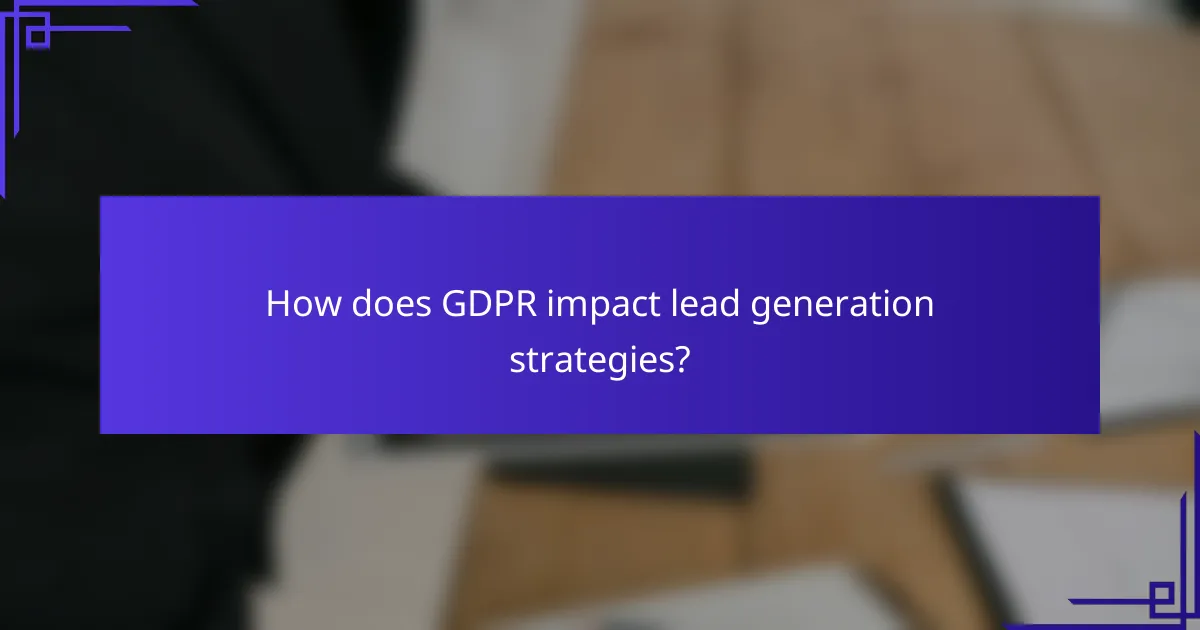
How does GDPR impact lead generation strategies?
GDPR significantly affects lead generation strategies by enforcing strict rules on data collection and consent. Businesses must ensure they obtain explicit permission from individuals before processing their personal data, which directly influences how leads are generated and nurtured.
Focus on quality over quantity
Prioritizing quality leads is essential under GDPR, as it reduces the risk of non-compliance and enhances engagement. Instead of casting a wide net, businesses should target specific audiences that are more likely to convert, ensuring that their marketing efforts are both effective and compliant.
To achieve this, consider segmenting your audience based on interests and behaviors. This approach not only improves lead quality but also aligns with GDPR’s emphasis on relevant and personalized communication.
Utilize double opt-in methods
Implementing double opt-in methods is a best practice for GDPR compliance in lead generation. This process requires potential leads to confirm their interest twice, first by signing up and then by verifying their email address through a confirmation link.
This method not only ensures that you have explicit consent but also helps maintain a clean email list, as it filters out uninterested parties. As a result, businesses can focus their resources on leads that are genuinely interested in their offerings.
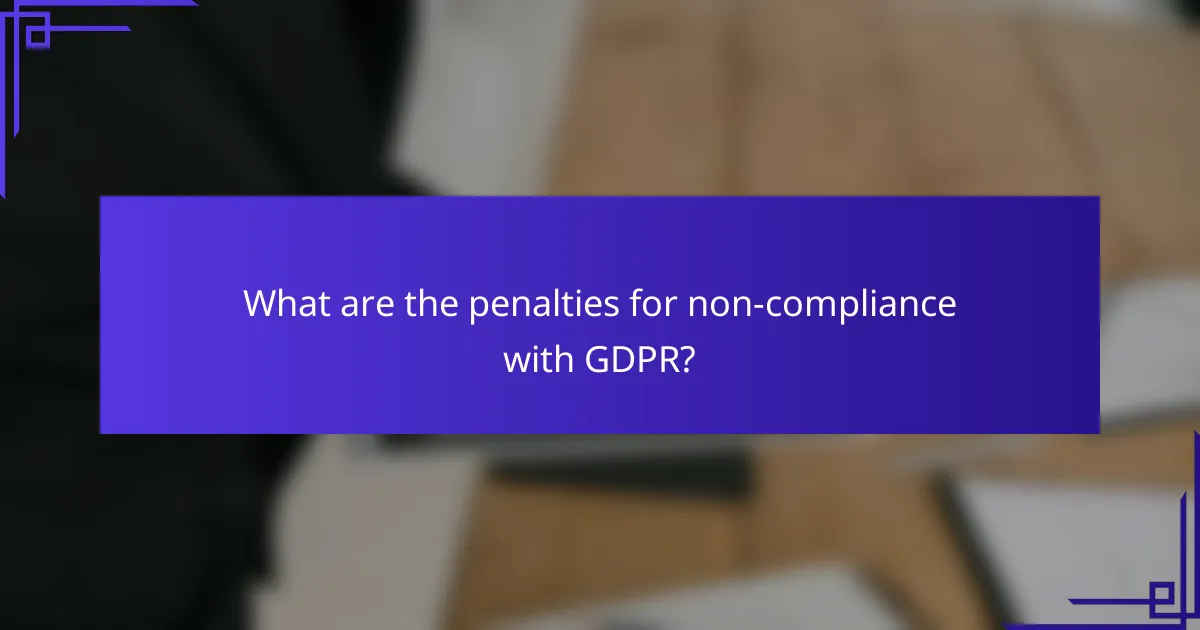
What are the penalties for non-compliance with GDPR?
Non-compliance with the General Data Protection Regulation (GDPR) can lead to severe penalties, including hefty fines and damage to an organization’s reputation. Understanding these penalties is crucial for businesses operating within the EU or dealing with EU citizens.
Fines up to €20 million or 4% of annual revenue
The GDPR imposes fines that can reach up to €20 million or 4% of a company’s annual global revenue, whichever is higher. This means that for large corporations, the financial repercussions can be substantial, potentially amounting to millions of euros.
To avoid such penalties, organizations should ensure they have robust data protection policies in place. Regular audits and compliance checks can help identify vulnerabilities and mitigate risks before they lead to costly fines.
Reputational damage
In addition to financial penalties, non-compliance with GDPR can result in significant reputational damage. Customers are increasingly aware of data privacy issues, and a breach can lead to loss of trust and customer loyalty.
To protect their reputation, businesses should prioritize transparency in their data handling practices. Communicating clearly about how customer data is used and ensuring compliance can help maintain a positive public image and foster customer confidence.
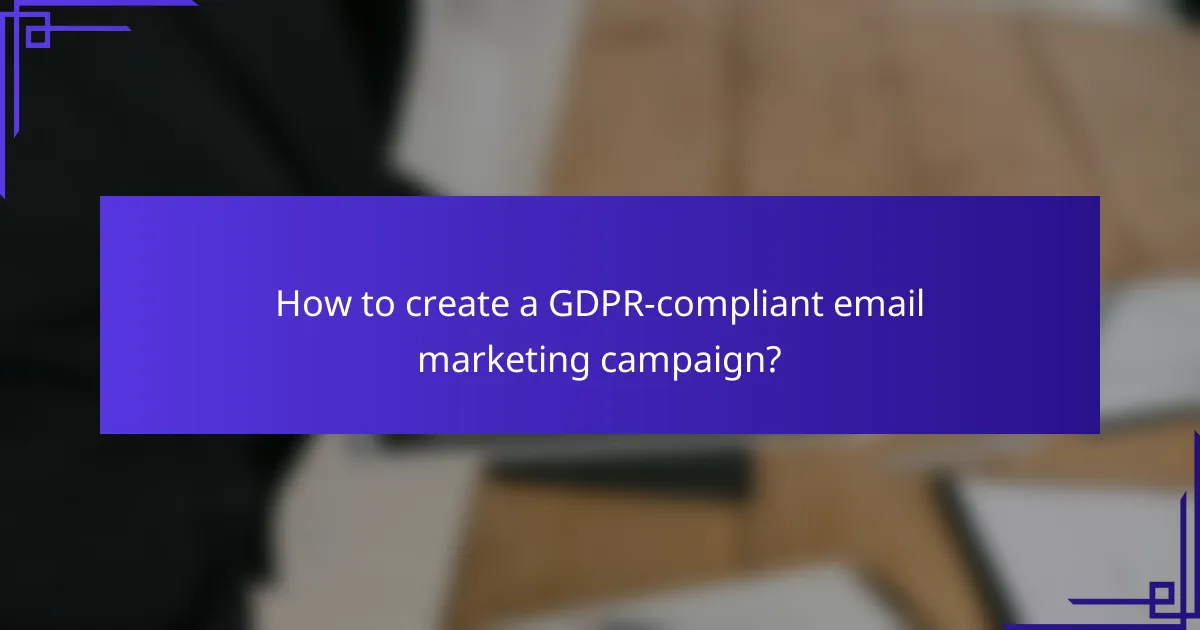
How to create a GDPR-compliant email marketing campaign?
To create a GDPR-compliant email marketing campaign, you must ensure that you have explicit consent from your recipients, provide clear information about data usage, and allow easy opt-out options. Compliance involves understanding the regulations and implementing best practices in your email strategy.
Define your target audience
Identifying your target audience is crucial for effective email marketing. Focus on segments that are likely to engage with your content, such as previous customers or individuals who have shown interest in your products. This targeted approach not only increases engagement but also helps in obtaining consent from relevant recipients.
Utilize tools like surveys or website analytics to gather insights about your audience. Understanding demographics, preferences, and behaviors will guide your content creation and ensure that your emails resonate with the right people.
Craft compliant email content
Your email content must be transparent and informative. Clearly state who you are, what data you collect, and how it will be used. This builds trust and ensures compliance with GDPR requirements. Use simple language and avoid jargon to make your message accessible.
Include a clear call-to-action and an easy way for recipients to unsubscribe. This not only complies with regulations but also enhances user experience. Regularly review your content for compliance and relevance to maintain engagement and avoid penalties.
Use compliant email service providers
Selecting an email service provider (ESP) that prioritizes GDPR compliance is essential. Look for providers that offer features like double opt-in, data encryption, and easy unsubscribe options. These features help you manage consent and protect recipient data effectively.
Research and compare ESPs based on their compliance track record and user reviews. Ensure that they provide clear documentation on how they handle data and comply with GDPR standards. This will help you maintain a compliant email marketing strategy while focusing on lead generation.
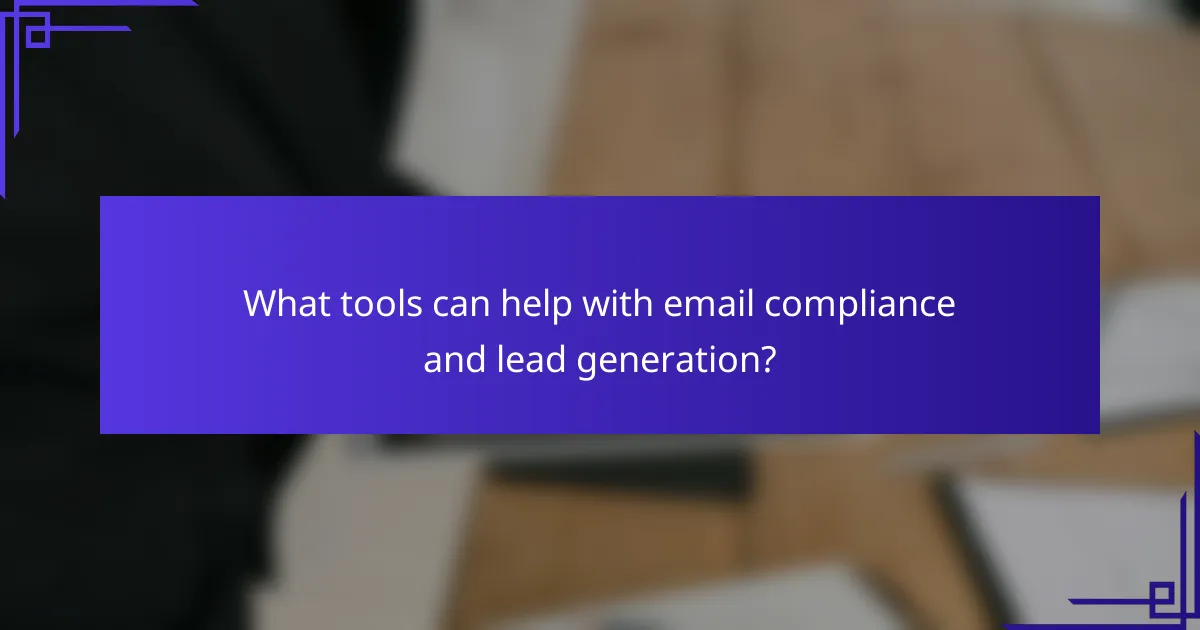
What tools can help with email compliance and lead generation?
Several tools can assist with email compliance and lead generation, ensuring that your campaigns adhere to regulations like GDPR while effectively capturing leads. Utilizing platforms like Mailchimp and HubSpot can streamline your processes and enhance your marketing efforts.
Mailchimp for compliance tracking
Mailchimp offers features specifically designed for compliance tracking, making it easier to manage subscriber consent and preferences. The platform provides customizable sign-up forms that can include GDPR-compliant checkboxes, ensuring that you collect explicit consent from users.
Additionally, Mailchimp’s reporting tools allow you to monitor engagement and compliance metrics. Regularly reviewing these reports can help you identify potential issues and adjust your strategies accordingly, ensuring that your email campaigns remain compliant with regulations.
HubSpot for lead management
HubSpot is a comprehensive lead management tool that integrates email marketing with customer relationship management (CRM). This integration helps you track leads through the sales funnel while ensuring that your email practices comply with GDPR and other regulations.
With HubSpot, you can segment your audience based on consent and engagement levels, allowing for targeted campaigns that respect user preferences. Utilizing HubSpot’s automation features can also streamline the process of following up with leads, enhancing your chances of conversion while maintaining compliance.
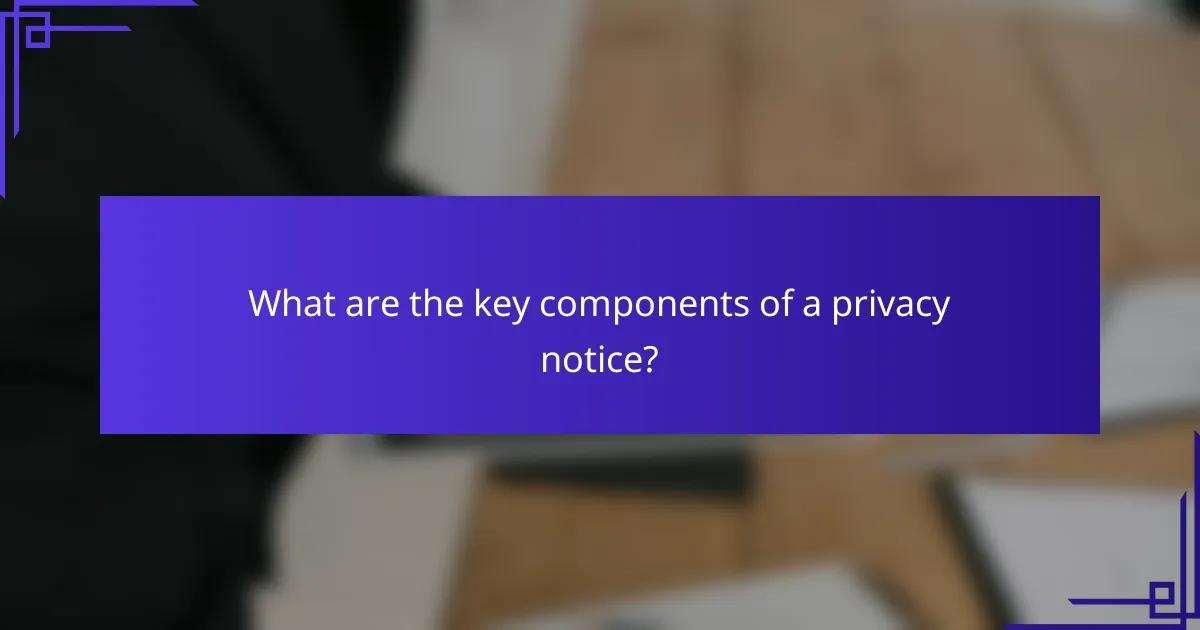
What are the key components of a privacy notice?
A privacy notice should clearly inform individuals about how their personal data is collected, used, and protected. Key components include the identity of the data controller, the purposes of data collection, and the rights of individuals regarding their data.
Data collection purposes
Understanding the purposes of data collection is crucial for compliance with privacy regulations like GDPR. Organizations must specify why they are collecting personal data, such as for marketing, service improvement, or legal compliance.
Common purposes include obtaining consent for newsletters, processing orders, or personalizing user experiences. Clearly stating these purposes helps build trust and ensures transparency with users.
When drafting a privacy notice, consider using straightforward language and examples to illustrate each purpose. For instance, if collecting data for targeted advertising, explain how this enhances user experience while providing an opt-out option.
